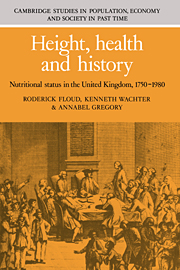Book contents
- Frontmatter
- Contents
- List of figures
- List of tables
- Preface
- 1 Height, nutritional status and the historical record
- 2 Inference from military height data
- 3 Inference from samples of military records
- 4 Long-term trends in nutritional status
- 5 Regional and occupational differentials in British heights
- 6 Height, nutritional status and the environment
- 7 Nutritional status and physical growth in Britain, 1750–1980
- 8 Conclusions
- Bibliography
- Index
Preface
Published online by Cambridge University Press: 05 November 2011
- Frontmatter
- Contents
- List of figures
- List of tables
- Preface
- 1 Height, nutritional status and the historical record
- 2 Inference from military height data
- 3 Inference from samples of military records
- 4 Long-term trends in nutritional status
- 5 Regional and occupational differentials in British heights
- 6 Height, nutritional status and the environment
- 7 Nutritional status and physical growth in Britain, 1750–1980
- 8 Conclusions
- Bibliography
- Index
Summary
One of the most striking features of the demographic history of North America, as of many other developed countries, has been the fall in mortality levels between the eighteenth and the twentieth centuries. This fall requires documentation and explanation; both were the task of a research programme begun in the late 1970s, under the auspices of the National Bureau of Economic Research, into ‘The Decline of Mortality in North America’. But, as Robert Fogel, who inspired the research programme, soon recognised, explanation of the fall in American mortality involved a search beyond North America; from the beginning of settlement until the First World War, the millions of immigrants who settled in the new world brought with them the culture, the habits of diet and of clothing and the health which they had acquired in the old.
Any explanation of the decline in mortality thus had to confront the question of how far the mortality levels of North America should be attributed to the health of the immigrants and of their immediate descendants who shared their customs and how far to the environment which they found in their new country. But to answer such a question required in its turn knowledge of the environment which they had left and which, in conjunction with their incomes and habits, had shaped their health.
- Type
- Chapter
- Information
- Height, Health and HistoryNutritional Status in the United Kingdom, 1750–1980, pp. xvii - xxiiPublisher: Cambridge University PressPrint publication year: 1990

